Do Countries Have “Synthetic” Traits?
Contents
Do Countries Have “Synthetic” Traits?#
Bill Alive
Last updated: 2022 Sep 13
Abstract#
Using personal survey data with hundreds of personality features, psychologists have discovered the “Big Five” synthetic personality traits (conscientiousness, extroversion, agreeableness, neuroticism, and openness to experience) that can give a useful view of a human personality in only five dimensions.
Can worldwide data on country indicators yield an analogous set of “synthetic” country traits?
In this project, Principal Component Analysis (PCA) was used on the World Bank World Development Indicators dataset for 2018 to extract five synthetic country traits. Each of these traits reveals an intriguing set of indicators with which it is most and least correlated. The highest and lowest scoring countries for each trait are also presented.
Note
This notebook is adapted from my final project for the first course in my MicroMasters in Data Science from UC San Diego.
This assignment imposed a fairly strict template, which I have (mostly) followed here.
Summary PDF
For a shorter summary of these findings, read the
original PDF version.
The Problem#
“Summary” Indicators Are Inherently Biased#
As we try to make sense of the world, the data can be overwhelming. We want to know, and quantify, which indicators really matter, but there are so many.
Custom indicators, like the Economic Freedom Ranking or the Human Development Index, can seem like the solution. Here, at last, is a single number that can tell us something important about the differences between countries.
The problem?
By definition, these custom indicators focus only on some of the data. The metric is only meaningful to the degree that you agree with the presuppositons of the researchers.
Example: Compare These Presumptions#
Consider the radically different views which underly the two indicators mentioned above.
…the EFW [Economic Freedom of the World] measure is an effort to identify how closely the institutions and policies of a country correspond with a limited government ideal, where the government protects property rights and arranges for the provision of a limited set of “public goods” such as national defense and access to money of sound value, but little beyond these core functions.
The Human Development Index (HDI) is a summary measure of average achievement in key dimensions of human development: a long and healthy life, being knowledgeable and have a decent standard of living.
Now, if you do agree with the presuppositions, then such indicators can be very useful. A doctor diagnosing lung cancer will also want to make assumptions and limit the data used for their diagnosis.
Can We Set Presuppositions Aside?#
But what if we only want to know the most distinctive traits that distinguish countries from each other, whatever they might be?
A Possible Solution#
“Synthetic” Country Traits#
In psychology, extensive analysis of personality survey data has led to the taxonomy of the “Big Five” personality traits: openness to experience, conscientiousness, extroversion, agreeableness, and neuroticism.
Each of these “synthetic” traits is associated with many specific factors that are highly correlated. For example, a person who scores highly on extroversion is more likely to show traits like sociability, assertiveness, activity, and talkativeness.
Instead of trying to make sense of a personality in hundreds of dimensions, these traits allow us to get a highly useful, quantified view of a person’s most striking tendencies using only five numbers.
Can we find similar “synthetic” traits for countries?
The WorldBank World Development Indicators dataset offers over a thousand indicators on the countries of the world. In this project, we will perform the same Principal Component Analysis (PCA) technique on this rich dataset as the PCA demonstrated with personality survey data in Week 9 of the UCSD DSS220x Machine Learning Fundamentals course, “9.4 Case Study: Personality Assessment”.
Our goal is to extract the top principal components from this data and examine these new “synthetic” traits. Will they have the potential to be as useful and meaningful as the Big Five personality traits?
Our Dataset#
World Bank: World Development Indicators#

The World Development Indicators dataset is the “World Bank’s premier compilation of cross-country comparable data on development.”
The full dataset includes data from 1960 to 2021. Each row consists of a country (or country grouping, like “High income”), an indicator, and then, for each year, a separate column holding that indicator’s value for that country in that year.
For this project, I focused on a single year of data. The most recent years do not have quite as much data, so I chose to use 2018, for which there are:
171,100non-null data pointsDistributed across
1,286separate indicators
Research Questions#
Can we use Principal Component Analysis to extract “synthetic” country traits from world indicator data?
Will these traits correspond to recognizable “features” of countries, the way the Big Five personality traits like extroversion make intuitive sense?
If not, will they provide any other interesting or useful insights? Can they show us any surprising correlations between indicators that we might not easily see otherwise?
Methods#
I used Principal Component Analysis to extract the top five “synthetic traits” from the world indicator data. I carefully followed the same steps outlined in video 9.4 from the UC San Diego DSE220x Machine Learning Fundamentals course, “Case Study: Personality Assessment”.
I also relied on the Week 9 notebook for that course, which performs PCA on the MNIST dataset of handwritten digits.
With personality survey data, PCA can yield not only the synthetic traits themselves, but also:
the personality features most and least correlated with these traits
each person’s individual score for each trait.
This project shows how using PCA on world indicator data can yield similar results for countries.
Setup#

Click to show
import pandas as pd
import numpy as np
import random
import matplotlib.pyplot as plt
from adjustText import adjust_text
from sklearn.preprocessing import MinMaxScaler
from sklearn.preprocessing import MaxAbsScaler
from sklearn.preprocessing import StandardScaler
from IPython.display import Markdown as md
## The charts show some warnings, so let's hide those.
import warnings
warnings.filterwarnings("ignore")
Data Preparation and Cleaning#
Before we compute the covariance matrix, we need to prepare our data.
Summary of Steps Taken Below#
Remove the data for all years except 2018.
Remove rows for country groups. This project focuses only on individual countries. Indicators like “Gross National Product” for groups like “High income” would have introduced (even more) extreme variance into the data.
Scale data to a normal distribution using sklearn StandardScaler().
Replace missing values with zero. This may not be the optimal solution, but zero is the mean value after scaling. In future analysis, a more nuanced approach might involve removing missing values from the calculations entirely.
See also
For the helper functions I wrote to prepare this dataset, see my WDI helper functions.
Click to show
# Load helper functions for this dataset.
%run ../lib/WDI.ipynb
data = get_wdi()
Remove Country “Groups”#
One problem with this dataset is that includes “groups” of countries, like “High Income” or even “World”. In this context, the variance between countries is already extreme enough; these groupings will only excacerbate this problem. Let’s remove everything except actual countries.
Click to show
data = wdi_remove_groups(data)
Choose Which Year to Study#
For this project, we will consider a “snapshot” with all the indicators available for a particular year. A more complete analysis would include data from all available years, but this is problematic for multiple reasons, not least of which is the wide variance in this dataset across years.
Let’s choose as recent a year as possible, but one which has as much data as possible.
How Many Data Points Are Available in Each Year?#
Click to show
wdi_show_by_year(data, recent=10)
Total rows: 312914
Limiting to the most recent 10 years.
Year Entries
2013 174605
2014 180448
2015 177736
2016 176842
2017 175140
2018 171100
2019 158408
2020 127080
2021 52770
Hmm. The most recent few years seem to have much less data than the preceding years. We’ll choose the most recent year that has a good amount of data points.
Our Choice: 2018#
year = 2018
Click to show
df = wdi_pivot(data, year=year,pivot_column='Indicator Code')
df
| Indicator Code | AG.CON.FERT.PT.ZS | AG.CON.FERT.ZS | AG.LND.AGRI.K2 | AG.LND.AGRI.ZS | AG.LND.ARBL.HA | AG.LND.ARBL.HA.PC | AG.LND.ARBL.ZS | AG.LND.CREL.HA | AG.LND.CROP.ZS | AG.LND.FRST.K2 | ... | per_sa_allsa.cov_q4_tot | per_sa_allsa.cov_q5_tot | per_si_allsi.adq_pop_tot | per_si_allsi.ben_q1_tot | per_si_allsi.cov_pop_tot | per_si_allsi.cov_q1_tot | per_si_allsi.cov_q2_tot | per_si_allsi.cov_q3_tot | per_si_allsi.cov_q4_tot | per_si_allsi.cov_q5_tot |
|---|---|---|---|---|---|---|---|---|---|---|---|---|---|---|---|---|---|---|---|---|---|
| Country Code | |||||||||||||||||||||
| ABW | 0.000000 | 0.000000 | 20.00 | 11.111111 | 2000.0 | 0.018895 | 11.111111 | 0 | 0.000000 | 4.2 | ... | 0.000000 | 0.00000 | 0.000000 | 0.000000 | 0.000000 | 0.000000 | 0.000000 | 0.000000 | 0.000000 | 0.000000 |
| AFG | 369.324810 | 7.650676 | 379190.00 | 58.081365 | 7703000.0 | 0.207226 | 11.798854 | 1912634 | 0.330852 | 12084.4 | ... | 0.000000 | 0.00000 | 0.000000 | 0.000000 | 0.000000 | 0.000000 | 0.000000 | 0.000000 | 0.000000 | 0.000000 |
| AGO | 0.000000 | 7.930094 | 569524.90 | 45.682594 | 4900000.0 | 0.159040 | 3.930376 | 3245206 | 0.252667 | 677175.1 | ... | 17.259922 | 14.61893 | 54.712662 | 0.821459 | 3.632175 | 0.718997 | 2.145329 | 3.193753 | 4.284947 | 7.815573 |
| ALB | 0.000000 | 66.585076 | 11740.81 | 42.849672 | 611346.0 | 0.213282 | 22.311898 | 140110 | 3.089562 | 7889.0 | ... | 0.000000 | 0.00000 | 0.000000 | 0.000000 | 0.000000 | 0.000000 | 0.000000 | 0.000000 | 0.000000 | 0.000000 |
| AND | 0.000000 | 0.000000 | 188.30 | 40.063830 | 830.0 | 0.010778 | 1.765957 | 0 | 0.000000 | 160.0 | ... | 0.000000 | 0.00000 | 0.000000 | 0.000000 | 0.000000 | 0.000000 | 0.000000 | 0.000000 | 0.000000 | 0.000000 |
| ... | ... | ... | ... | ... | ... | ... | ... | ... | ... | ... | ... | ... | ... | ... | ... | ... | ... | ... | ... | ... | ... |
| XKX | 0.000000 | 0.000000 | 0.00 | 0.000000 | 0.0 | 0.000000 | 0.000000 | 0 | 0.000000 | 0.0 | ... | 0.000000 | 0.00000 | 0.000000 | 0.000000 | 0.000000 | 0.000000 | 0.000000 | 0.000000 | 0.000000 | 0.000000 |
| YEM | 0.000000 | 3.832632 | 233877.00 | 44.297403 | 1097700.0 | 0.038518 | 2.079095 | 630061 | 0.549274 | 5490.0 | ... | 0.000000 | 0.00000 | 0.000000 | 0.000000 | 0.000000 | 0.000000 | 0.000000 | 0.000000 | 0.000000 | 0.000000 |
| ZAF | 238.147139 | 72.833333 | 963410.00 | 79.417850 | 12000000.0 | 0.207639 | 9.892094 | 3034761 | 0.340453 | 171228.9 | ... | 0.000000 | 0.00000 | 0.000000 | 0.000000 | 0.000000 | 0.000000 | 0.000000 | 0.000000 | 0.000000 | 0.000000 |
| ZMB | 0.000000 | 52.510934 | 238360.00 | 32.063923 | 3800000.0 | 0.218999 | 5.111718 | 1208016 | 0.048427 | 451904.6 | ... | 0.000000 | 0.00000 | 0.000000 | 0.000000 | 0.000000 | 0.000000 | 0.000000 | 0.000000 | 0.000000 | 0.000000 |
| ZWE | 345.495495 | 38.350000 | 162000.00 | 41.876696 | 4000000.0 | 0.277031 | 10.339925 | 1641701 | 0.258498 | 175367.2 | ... | 0.000000 | 0.00000 | 0.000000 | 0.000000 | 0.000000 | 0.000000 | 0.000000 | 0.000000 | 0.000000 | 0.000000 |
217 rows × 1286 columns
Scale values#
In a standard personality survey, each feature is rated on the same scale, e.g. from 1 to 5.
Here, the scale between features varies wildly. The Gross National Income (GNI) of a country could be in the trillions, while other features are percentages between 0 and 100.
We will use a scaler from sklearn.preprocessing to get all the data to the same scale.
Click to show
## See https://datagy.io/pandas-normalize-column/
## Let's try different scaling methods.
#scaler = MaxAbsScaler()
#scaler = MinMaxScaler()
scaler = StandardScaler()
scaler.fit(df)
scaled = scaler.transform(df)
scaled_df = pd.DataFrame(scaled, columns=df.columns, index=df.index)
## Replace NaN with zero.
scaled_df = scaled_df.fillna(0)
## Suppress scientific notation for this preview
scaled_df.round(3)
| Indicator Code | AG.CON.FERT.PT.ZS | AG.CON.FERT.ZS | AG.LND.AGRI.K2 | AG.LND.AGRI.ZS | AG.LND.ARBL.HA | AG.LND.ARBL.HA.PC | AG.LND.ARBL.ZS | AG.LND.CREL.HA | AG.LND.CROP.ZS | AG.LND.FRST.K2 | ... | per_sa_allsa.cov_q4_tot | per_sa_allsa.cov_q5_tot | per_si_allsi.adq_pop_tot | per_si_allsi.ben_q1_tot | per_si_allsi.cov_pop_tot | per_si_allsi.cov_q1_tot | per_si_allsi.cov_q2_tot | per_si_allsi.cov_q3_tot | per_si_allsi.cov_q4_tot | per_si_allsi.cov_q5_tot |
|---|---|---|---|---|---|---|---|---|---|---|---|---|---|---|---|---|---|---|---|---|---|
| Country Code | |||||||||||||||||||||
| ABW | -0.118 | -0.412 | -0.363 | -1.097 | -0.322 | -0.723 | -0.166 | -0.305 | -0.551 | -0.252 | ... | -0.306 | -0.286 | -0.316 | -0.218 | -0.271 | -0.210 | -0.239 | -0.259 | -0.282 | -0.318 |
| AFG | 0.117 | -0.391 | 0.260 | 0.979 | 0.064 | 0.136 | -0.115 | -0.131 | -0.507 | -0.236 | ... | -0.306 | -0.286 | -0.316 | -0.218 | -0.271 | -0.210 | -0.239 | -0.259 | -0.282 | -0.318 |
| AGO | -0.118 | -0.391 | 0.573 | 0.431 | -0.077 | -0.084 | -0.700 | -0.010 | -0.517 | 0.661 | ... | 0.993 | 1.327 | 3.334 | 0.186 | 0.157 | -0.113 | 0.020 | 0.100 | 0.180 | 0.504 |
| ALB | -0.118 | -0.229 | -0.344 | 0.306 | -0.292 | 0.164 | 0.666 | -0.292 | -0.141 | -0.242 | ... | -0.306 | -0.286 | -0.316 | -0.218 | -0.271 | -0.210 | -0.239 | -0.259 | -0.282 | -0.318 |
| AND | -0.118 | -0.412 | -0.363 | 0.183 | -0.322 | -0.760 | -0.861 | -0.305 | -0.551 | -0.252 | ... | -0.306 | -0.286 | -0.316 | -0.218 | -0.271 | -0.210 | -0.239 | -0.259 | -0.282 | -0.318 |
| ... | ... | ... | ... | ... | ... | ... | ... | ... | ... | ... | ... | ... | ... | ... | ... | ... | ... | ... | ... | ... | ... |
| XKX | -0.118 | -0.412 | -0.363 | -1.589 | -0.322 | -0.810 | -0.992 | -0.305 | -0.551 | -0.252 | ... | -0.306 | -0.286 | -0.316 | -0.218 | -0.271 | -0.210 | -0.239 | -0.259 | -0.282 | -0.318 |
| YEM | -0.118 | -0.402 | 0.021 | 0.370 | -0.267 | -0.634 | -0.838 | -0.248 | -0.478 | -0.245 | ... | -0.306 | -0.286 | -0.316 | -0.218 | -0.271 | -0.210 | -0.239 | -0.259 | -0.282 | -0.318 |
| ZAF | 0.033 | -0.212 | 1.221 | 1.922 | 0.279 | 0.138 | -0.257 | -0.029 | -0.506 | -0.021 | ... | -0.306 | -0.286 | -0.316 | -0.218 | -0.271 | -0.210 | -0.239 | -0.259 | -0.282 | -0.318 |
| ZMB | -0.118 | -0.268 | 0.029 | -0.171 | -0.132 | 0.190 | -0.612 | -0.195 | -0.544 | 0.357 | ... | -0.306 | -0.286 | -0.316 | -0.218 | -0.271 | -0.210 | -0.239 | -0.259 | -0.282 | -0.318 |
| ZWE | 0.102 | -0.307 | -0.097 | 0.263 | -0.122 | 0.455 | -0.224 | -0.156 | -0.517 | -0.016 | ... | -0.306 | -0.286 | -0.316 | -0.218 | -0.271 | -0.210 | -0.239 | -0.259 | -0.282 | -0.318 |
217 rows × 1286 columns
Sanity Check: What Are Our Max and Min Values After Scaling?#
Let’s do a sanity check and see what our max and min values are after scaling.
How extreme are these ranges?
Click to show
ind = max(scaled_df)
ind
max_min = []
for col in scaled_df.columns:
max_min.append(( \
col, \
get_indicator_name(data, col), \
round(max(scaled_df[col]), 3), \
round(min(scaled_df[col]), 3), \
round(np.mean(scaled_df[col]), 5), \
round(np.std(scaled_df[col]),3)
))
def style_max_min(df):
"""Style max/min dataframes."""
return df.style\
.format(precision=1)\
.hide(['code'], axis='columns')\
.hide(axis='index')\
.set_properties(**{'text-align': 'left'})\
.set_table_styles([dict(selector = 'th', props=[('text-align', 'left')])])
max_min_df = pd.DataFrame(max_min, columns = ['code', 'name','max','min','mean','std']).sort_values(['max'])
Max Values#
Click to show
style_max_min(max_min_df.sort_values('max',ascending=False).head(5)).highlight_max('max',axis='columns')
| name | max | min | mean | std |
|---|---|---|---|---|
| Progression to secondary school (%) | 14.7 | -0.1 | 0.0 | 1.0 |
| Renewable electricity output (% of total electricity output) | 14.7 | -0.1 | 0.0 | 1.0 |
| Progression to secondary school, female (%) | 14.7 | -0.1 | 0.0 | 1.0 |
| Increase in poverty gap at $3.20 ($ 2011 PPP) poverty line due to out-of-pocket health care expenditure (% of poverty line) | 14.7 | -0.1 | -0.0 | 1.0 |
| Increase in poverty gap at $3.20 ($ 2011 PPP) poverty line due to out-of-pocket health care expenditure (USD) | 14.7 | -0.1 | 0.0 | 1.0 |
Min Values#
Click to show
style_max_min(max_min_df.sort_values('min').head(5)).highlight_min('min', axis='columns')
| name | max | min | mean | std |
|---|---|---|---|---|
| Foreign direct investment, net inflows (% of GDP) | 0.4 | -14.7 | 0.0 | 1.0 |
| Net lending (+) / net borrowing (-) (current LCU) | 2.5 | -14.3 | 0.0 | 1.0 |
| Net primary income (Net income from abroad) (constant LCU) | 2.7 | -14.1 | 0.0 | 1.0 |
| Terms of trade adjustment (constant LCU) | 0.5 | -14.0 | 0.0 | 1.0 |
| Net capital account (BoP, current US$) | 3.3 | -13.8 | 0.0 | 1.0 |
Are These Variances Too Extreme?#
Hmm. In a standard Gaussian distribution, we wouldn’t expect to see many numbers beyond positive or negative 3, i.e. more than three standard deviations from the mean. But here we see positive and negative 14.
These highs and lows seem rather extreme. Is something going wrong with our scaling?
On the other hand, the means do appear to be zero, and the standard deviation is one.
Perhaps it makes sense that we would see extreme differences between countries. This dataset ranges from tiny island nations to massive populations like China and India.
Still, it may be naive to think that we can compare countries of such massively different scale without further adjustment. For instance, it may be that all features connected with absolute quantities like gross income or forest acreage should be “normalized” to a number per capita. That would require a manual review of nearly 1300 features, though, and is thus outside the scope of this initial exploration.
For now, let’s proceed.
Compute#
Compute covariance matrices#
Note: This PCA analysis follows the PCA_MNIST notebook in DSE-220x Week 9.
Click to show
## Set df to our scaled df
df = scaled_df
## Compute covariance matrix
Sigma = np.cov(df, rowvar=0, bias=1)
## Compute eigenvectors
eigenvalues, eigenvectors = np.linalg.eigh(Sigma)
# eigenvectors.shape
Compute synthetic traits#
We are now ready to compute these synthetic traits.
Click to show
# Get the top k eigenvectors
k = 5
d = len(eigenvectors)
U = eigenvectors[:,(d-k):d]
# This matrix will perform PCA projection onto the top k eigenvectors
U.T
# Initialize a dataframe of these traits, indexed with country codes.
traits = pd.DataFrame(index = df.index, columns = range(0,k))
# For each country, project its features onto each of the top k eigenvectors,
# resulting in this country's score for this synthetic trait.
for country in df.index:
for trait in range(0,k):
traits.loc[country][trait] = np.dot(df.loc[country],U.T[trait])
#head_num=10
#precision=2
#traits.head(head_num).style.format(precision=precision)
Traits by Country, Normal Scale#
We have our traits!
True, we have no idea whether they mean anything yet. But let’s see they are each distributed across the 217 countries.
Trait 0 is based on the first principal component, trait 1 on the second, etc.
Click to show
plt.rcParams['figure.dpi'] = 150
for trait in range(0,k):
fig, axis = plt.subplots()
plt.suptitle(f"Synthetic Trait {trait} by Country ({year})")
plt.bar(traits.index, np.sort(traits[trait]))
# Hide xticks
plt.xticks([])
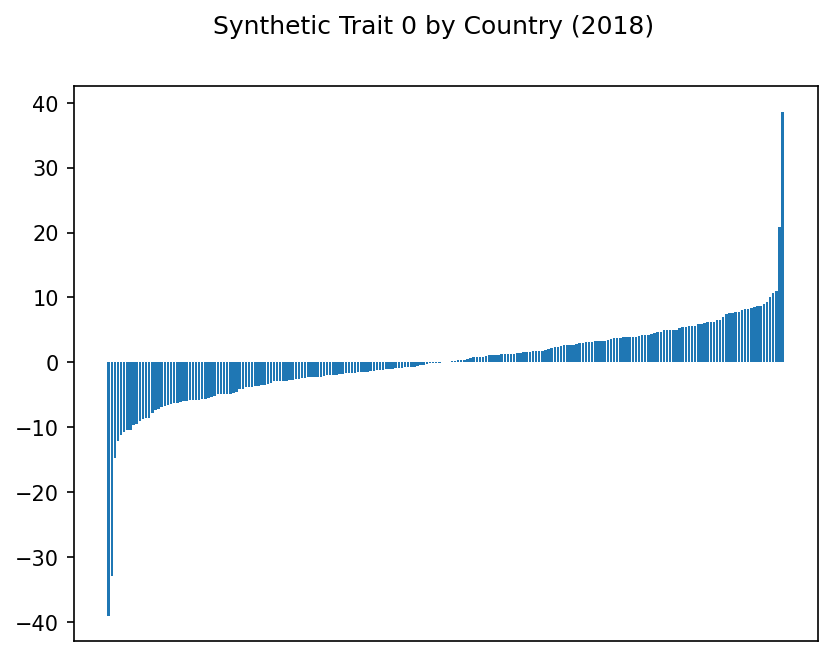

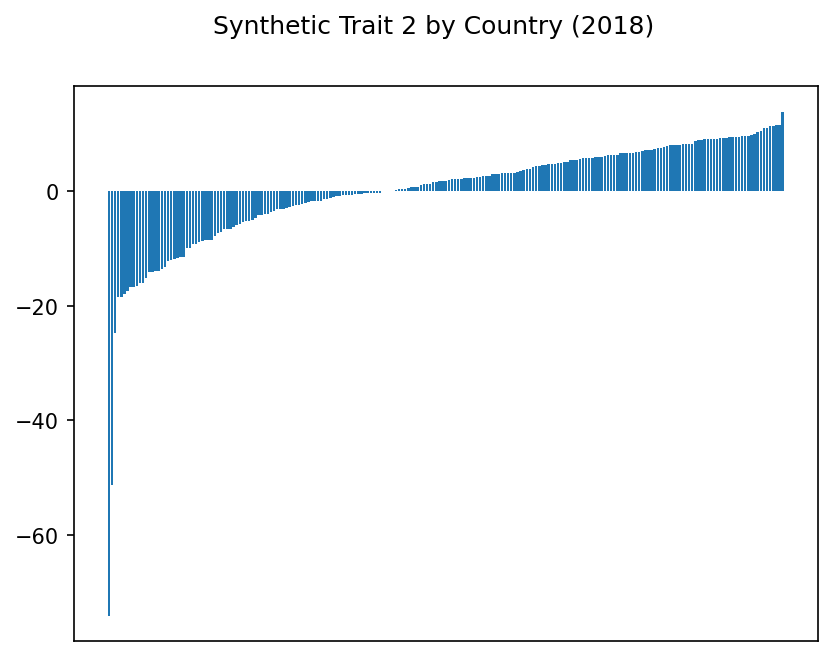
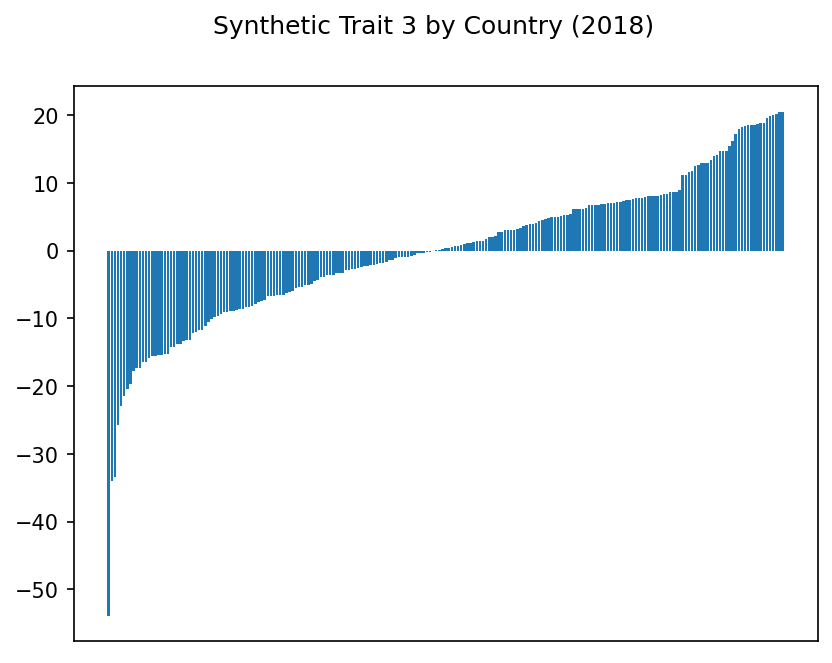
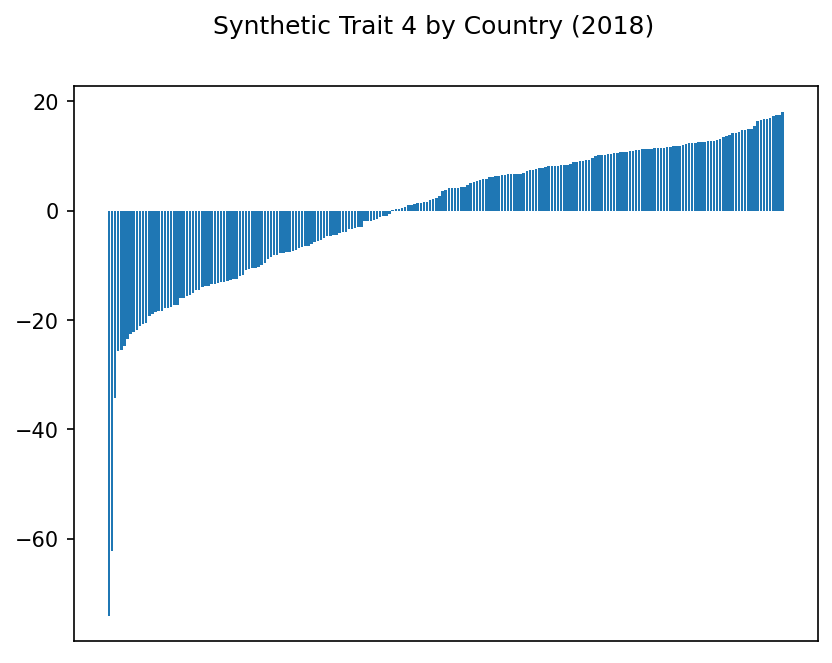
Hmm. Some of these traits show some suspiciously extreme highs and lows. Even with our scaling above, it may be that outliers are disproportionately affecting the results.
Let’s try a logarithmic scale.
Traits by Country, Logarithmic Scale#
Click to show
for trait in range(0,k):
fig, axis = plt.subplots()
plt.suptitle(f"Synthetic Trait {trait} by Country, Logarithmic Scale ({year})")
plt.yscale("log")
plt.bar(range(0, len(traits)), np.sort(traits[trait]))

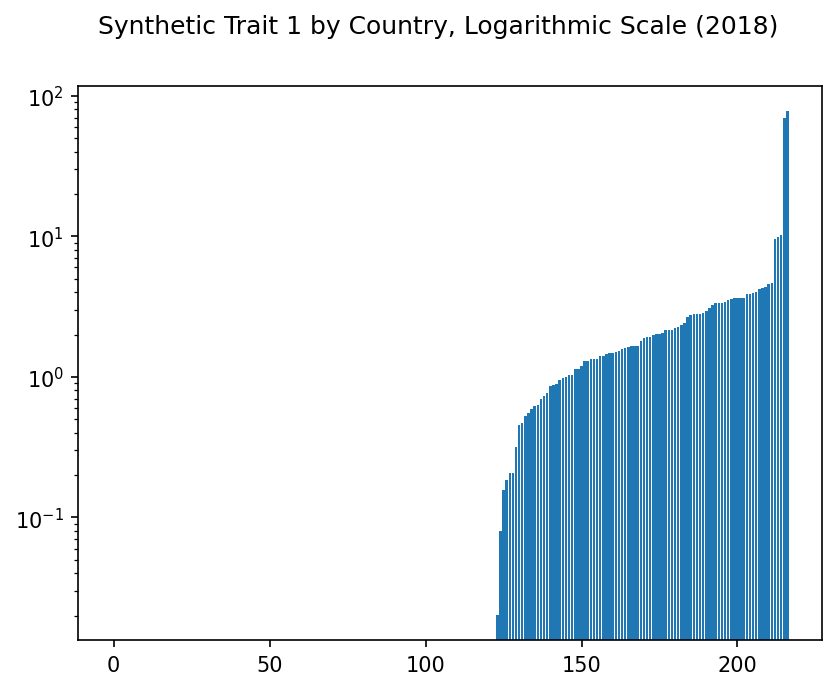
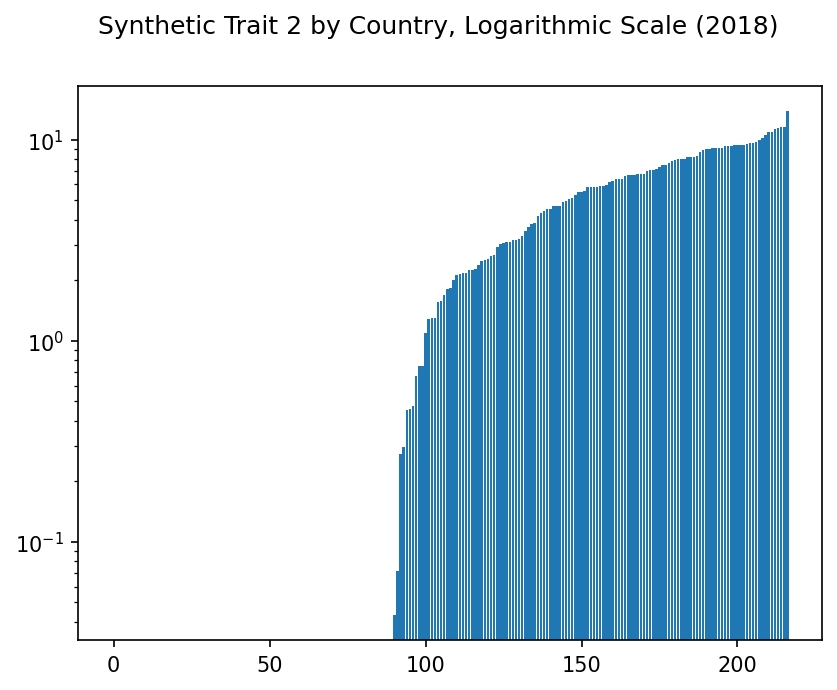

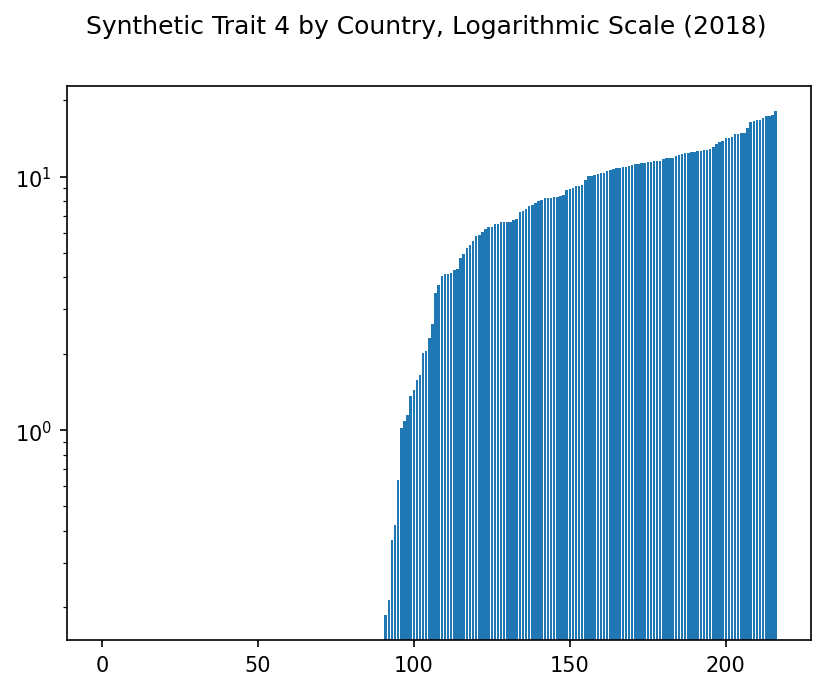
Interesting. Using a logarithmic scale doesn’t actually change anything, but at least these traits now appear more usable.
Now for the real question. What, if anything, do these traits actually mean?
Findings: Trait Indicators and Country Scores#
What are the top and bottom indicators in each synthetic trait, and which countries show the highest and lowest scores?
For each trait, we will take its dot product with each feature. Those features with the largest dot product with this trait should show the highest correlation with it.
Sample: Indicator and Country Scores#
Here is a sample of a few indicators and how highly they correlate with each trait:
Click to show
# Initialize a dataframe of these trait_indicators, indexed with indicator codes.
trait_inds = pd.DataFrame(index = df.columns, columns = range(0,k))
# For each indicator, project it onto the each our synthetic traits,
# resulting in this indicator's score for this synthetic trait.
for ind in trait_inds.index:
for trait in range(0,k):
trait_inds.loc[ind][trait] = np.dot(df[ind],traits[trait])
#trait_inds
ind_codes = data[['Indicator Code', 'Indicator Name']].drop_duplicates().set_index('Indicator Code')
#ind_codes
trait_inds['Indicator'] = ind_codes.loc[trait_inds.index]
col = trait_inds.pop('Indicator')
#col
head_num = 10
precision = 3
trait_inds.insert(0, col.name, col)
trait_inds.head(head_num).style.hide_index().format(precision=precision)
| Indicator | 0 | 1 | 2 | 3 | 4 |
|---|---|---|---|---|---|
| Fertilizer consumption (% of fertilizer production) | 11.808 | -10.409 | 192.598 | 59.729 | -270.269 |
| Fertilizer consumption (kilograms per hectare of arable land) | 76.846 | 12.167 | 241.815 | 146.969 | -839.630 |
| Agricultural land (sq. km) | 147.267 | -79.954 | -945.465 | -1119.706 | -1359.077 |
| Agricultural land (% of land area) | 24.961 | -178.938 | 271.580 | -890.937 | -52.046 |
| Arable land (hectares) | 101.772 | -60.683 | -982.213 | -1141.266 | -1411.117 |
| Arable land (hectares per person) | -92.998 | -157.199 | 451.134 | -447.154 | -616.196 |
| Arable land (% of land area) | 66.024 | -130.352 | 327.421 | -515.849 | -507.430 |
| Land under cereal production (hectares) | 337.211 | 79.111 | -1087.065 | -1274.725 | -1322.226 |
| Permanent cropland (% of land area) | 98.941 | 118.173 | -180.396 | 65.315 | 451.084 |
| Forest area (sq. km) | -0.667 | -27.196 | -455.737 | -600.136 | -969.488 |
Also, each country has a score for each trait. Let’s see a few of those scores.
Click to show
country_codes = data[['Country Code', 'Country Name']].drop_duplicates().set_index('Country Code')
#country_codes
traits['Country'] = country_codes.loc[traits.index]
col = traits.pop('Country')
traits.insert(0, col.name, col)
traits.head(head_num).style.hide_index().format(precision=precision)
| Country | 0 | 1 | 2 | 3 | 4 |
|---|---|---|---|---|---|
| Aruba | 1.375 | 1.810 | -9.954 | 14.657 | 6.054 |
| Afghanistan | -1.623 | -2.393 | -2.158 | -13.324 | 15.513 |
| Angola | -5.838 | -1.068 | -0.761 | -9.749 | 10.247 |
| Albania | 7.769 | 0.594 | 10.948 | -1.042 | -5.100 |
| Andorra | 3.158 | 3.364 | -13.288 | 18.509 | 7.222 |
| United Arab Emirates | -5.399 | -0.936 | 2.645 | 6.199 | -10.464 |
| Argentina | 8.330 | 3.656 | 6.190 | -5.370 | -10.565 |
| Armenia | 8.738 | 2.819 | 11.338 | -0.289 | -5.770 |
| American Samoa | 1.085 | 3.519 | -16.695 | 18.304 | 11.512 |
| Antigua and Barbuda | 4.167 | 0.467 | -2.785 | 7.777 | 4.124 |
Now we can examine each trait in detail. For each trait, we’ll show:
The indicators most and least correlated with each trait.
The countries with the highest and lowest scores for this trait.
Note that the scores themselves are fairly meaningless, except as relative numbers. I’ve included them only to show ranking.
See also
For the full data, see the Appendix.
Click to show
## Export the data to CSV for further analysis.
dir_output="output"
basename="traits"
file_traits_countries_year = f"{dir_output}/{basename}_countries_{year}.csv"
file_traits_indicators_year = f"{dir_output}/{basename}_indicators_{year}.csv"
traits.to_csv(file_traits_countries_year)
trait_inds.to_csv(file_traits_indicators_year)
# BUG: Jupyter Book cannot currently process markdown that is output by code.
# For now, we need to break up this for loop and do this manually.
# See https://github.com/executablebooks/MyST-NB/issues/317
def show_results(traits, trait_inds, k, ind_count=None, country_count=None):
for t in range(0,k):
# display(md("<hr/>"))
display(md(f"# Synthetic Trait {t}:"))
show = trait_inds[['Name', t]].sort_values(t, ascending=False)
if ind_count is not None:
display(md(f"## Most Correlated Indicators, Trait {t}"))
display(show.head(ind_count))
display(md(f"## Least Correlated Indicators, Trait {t}"))
display(show.tail(ind_count))
else:
display(md(f"## Indicator Scores, Trait {t}"))
max_rows=pd.get_option('display.max_rows')
pd.set_option('display.max_rows', None)
display(show)
pd.set_option('display.max_rows', max_rows)
if country_count is not None:
fig, axis = plt.subplots()
plt.suptitle(f"Highest and Lowest Scoring Countries, Trait {t} ({year})")
scores = traits[['Name', t]].sort_values(t).head(country_count)
display(scores)
plt.barh(scores['Name'], scores[t], color='red')
scores = traits[['Name', t]].sort_values(t).tail(country_count)
display(scores)
plt.barh(scores['Name'], scores[t], color='green')
else:
display(md(f"## Country Scores, Trait {t}"))
max_rows=pd.get_option('display.max_rows')
pd.set_option('display.max_rows', None)
display(traits[['Name', t]].sort_values(t, ascending=False))
pd.set_option('display.max_rows', max_rows)
return
# show_results(traits,trait_inds,k,ind_count=10,country_count=5)
def show_results_trait(trait, name, traits, trait_inds, ind_count=10):
t = trait
show = trait_inds[[t, 'Indicator']].sort_values(t, ascending=False)
show.rename(columns = {t:'Score'}, inplace=True)
scores_low = get_scores_low(t, traits)
scores_high = get_scores_high(t, traits)
if name == 'most_correlated':
display(show.head(ind_count)\
.style.format(precision=0)\
.set_properties(**{'text-align': 'left'})\
.set_table_styles(
[dict(selector = 'th', props=[('text-align', 'left')])])\
.hide(axis='index'))
elif name == 'least_correlated':
display(show.tail(ind_count)\
.style.format(precision=0)\
.set_properties(**{'text-align': 'left'})\
.set_table_styles(
[dict(selector = 'th', props=[('text-align', 'left')])])\
.hide(axis='index'))
elif name == 'scoring_countries_chart':
fig, axis = plt.subplots()
plt.suptitle(f"Highest and Lowest Scoring Countries, Trait {t} ({year})")
plt.barh(scores_low['Country'], scores_low[t], color='red')
plt.barh(scores_high['Country'], scores_high[t], color='green')
elif name == 'scoring_countries_tables':
display(scores_high)
display(scores_low)
def get_scores_low(t, traits, country_count=5):
return traits[['Country', t]].sort_values(t).head(country_count)
def get_scores_high(t, traits, country_count=5):
return traits[['Country', t]].sort_values(t).tail(country_count)
Synthetic Trait 0#
Analysis: Trait 0#
Striking Indicators: Trait 0
⬆️
+Debt
+Net Secondary Income
+Transport
⬇️
-ODA Provided
-Net Primary Income
What’s the most striking trait that sets countries apart? Apparently, it’s debt.
Well, not quite. The indicators most correlated with this trait are net secondary income. This seems to balance with two of the least correlated indicators being net primary income.
But 5 of the 10 topmost indicators here deal with debt. Plus, the countries scoring most highly on this trait are also least likely to provide ODA (Official Development Assistance) elsewhere.
The high investment in transport is intriguing, but the low correlation with imports of goods and services may be misleading; other related indicators dealing with imports are more highly correlated.
Highest and Lowest Scoring Countries, Trait 0#
Click to show
trait=0
show_results_trait(trait=trait,name='scoring_countries_chart',traits=traits,trait_inds=trait_inds)

Synthetic Trait 1#
Analysis: Trait 1#
Striking Indicators: Trait 1
⬆️
+GFCF
+Manufacturing
+Agriculture
⬇️
-ODA Provided
-Net Primary Income
For our next highest trait, the leading indicators are gross fixed capital formation (also called “investment”, see here) as well as manufacturing, industry, and agriculture.
Once again, we see net ODA provided and net primary income in the least correlated indicators.
So far, this seems to make sense. But then, what about the other leading indicators: imports, taxes, and household consumption? Should these correlate highly with manufacturing and agriculture?
Also, why do Indonesia and Iran have such high scores? Iran had an extremely low score on trait 0, so there may just be a problem with this country’s data. But trait 1 may need further analysis.
Highest and Lowest Scoring Countries, Trait 1#
Click to show
trait=1
show_results_trait(trait=trait,name='scoring_countries_chart',traits=traits,trait_inds=trait_inds)

Synthetic Trait 2#
Analysis: Trait 2#
Striking Indicators: Trait 2
⬆️
+SPI
+Older Population
+Labor %
⬇️
-Emissions
-Capital Formation
For Trait 2, the strongest indicators are, perhaps ironically, synthetic performance indicators created by the World Bank. But we also see intriguing correlations with adult and female population percentages and labor force participation rates.
Meanwhile, emissions dominate the least correlated indicators, along with gross capital formation (the opposite of trait 1).
Given the emissions issue, it’s no surprise to see the US and China with the lowest scores on this trait… but why are the Isle of Man and the Northern Mariana Islands down here as well? Missing data, perhaps? And do China and India also have low correlations with gross domestic savings… and industry? This trait requires further investigation.
Highest and Lowest Scoring Countries, Trait 2#
trait=2
show_results_trait(trait=trait,name='scoring_countries_chart',traits=traits,trait_inds=trait_inds)

Synthetic Trait 3#
Analysis: Trait 3#
Striking Indicators: Trait 3
⬆️
+GDP
+Electricity/Comms/Water
+Urban
⬇️
-Children
-Vulnerable/Self-Employed
At first, Trait 3 seems straightforward: wealth. The highest correlating indicator couldn’t be simpler: GDP per capita. Correlated with wealth, we see access to electricity, subscriptions to broadband and telephone, even safely managed drinking water, plus a higher percentage urban population.
Meanwhile, these rich countries have a lower percentage of children and lower rates of self-employment. All very neat… until you check the country scores.
They don’t seem to correlate with GDP per capita. Yes, Monaco and Isle of Man are both wealthy, and they score highly on this trait. But how can the United States possibly have one of the lowest scores, with a 2018 GDP per capita of $62,805? And Gibraltar, St. Martin, and the Northern Mariana Islands, it turns out, are missing GDP per capita data for 2018.
So while this trait is promising, something is amiss. Filling missing values with 0’s may have skewed these scores.
Highest and Lowest Scoring Countries, Trait 3#
Click to show
trait=3
show_results_trait(trait=trait,name='scoring_countries_chart',traits=traits,trait_inds=trait_inds)
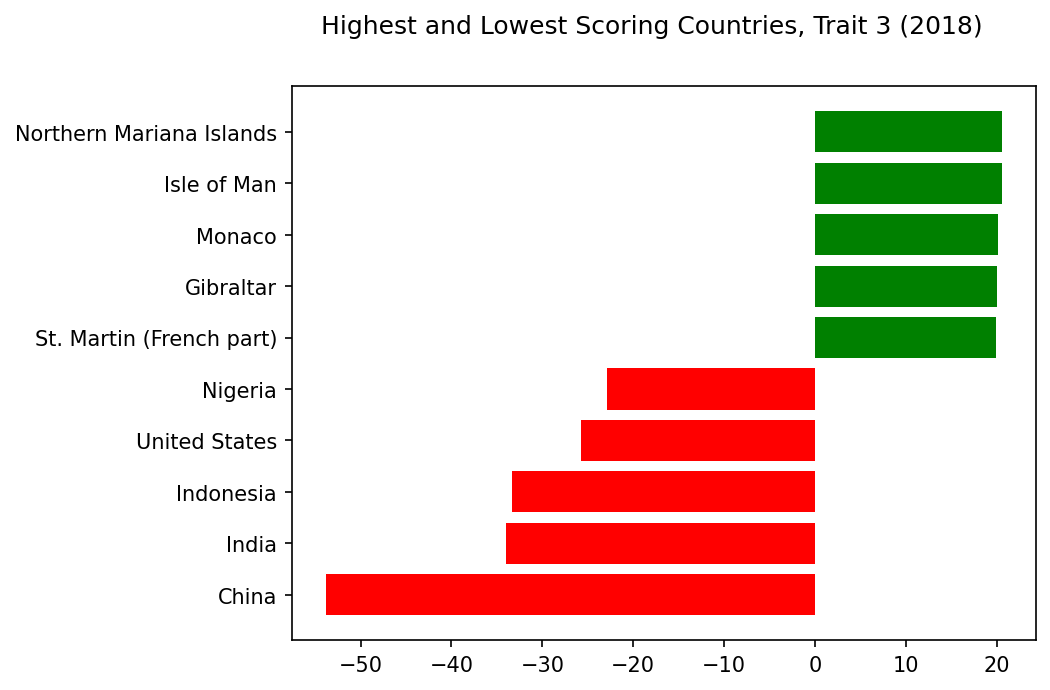
Synthetic Trait 4#
Analysis: Trait 4#
Striking Indicators: Trait 4
⬆️
+Child Mortality
+CPIA Ratings
⬇️
-Imports/Exports
-Health Expenditure
Trait 4 is heartbreaking. I never expected infant and child mortality to dominate one of these synthetic traits.
On the flip side, we see low correlations with health expenditure, as well as both imports and exports. This trait seems grim; you do not want a high score.
And yet, why does it also correlate with high scores on CPIA ratings? The World Bank states that its “Country Policy and Institutional Assessment is done annually for all its borrowing countries.” Presumably, high scores are desirable, so why would they correlate with high child mortality? Non-borrowing countries do not receive any CPIA ratings, so perhaps that explains the correlation, but it bears further study.
Highest and Lowest Scoring Countries, Trait 4#
Click to show
trait=4
show_results_trait(trait=trait,name='scoring_countries_chart',traits=traits,trait_inds=trait_inds)

Analysis: Are These Synthetic Indicators Meaningful?#
At first glance, these synthetic indicators seem disappointingly obvious.
A high or low score on a trait often seems heavily correlated, if not determined, by a country’s wealth level.
Is this a useful insight? Or would measures of wealth be less prominent if they were all normalized to a per capita share? An interesting question for further research.
Even so, there are some surprises. I’m intrigued by which indicators show up alongside economic indicators like income and debt. And I am startled and saddened to see how trait 4 confronts us with child mortality.
Meanwhile, while the high or low scores for some countries make intuitive sense, others seem confusing, if not downright incorrect.
In particular, the United States is one of the lowest scoring countries for every trait. Can this really be correct? Or does it indicate a problem with the method, especially the decision to fill missing values with zeroes?
Limitations#
This project was inspired by PCA performed on personality surveys that offered simple, consistent data. By contrast, the features in this data vary wildly by many orders of magnitude, from gross national income to percentages to CPIA ratings from 1 to 6. Despite a simple attempt to scale the data to a normal distribution, it may well be that far more nuanced work is required to make this data usable for PCA.
Similarly, the simple expedient of replacing missing values with zeroes may have been naive. Not only are different countries missing different values, but some countries are simply far more represented in the data. This higher rate of data collection may in itself be an indicator of wealth and infrastructure, which could mean that assigning zeros to countries without this benefit, when zero suggests a “mean” for a given indicator, is highly misleading.
In trait 4, for instance, having any value for the CPIA ratings, which apply only to borrower countries, seems to be more significant than the rating itself.
Also, even this vast dataset is inherently limited. Ideally, it should be easy to scale and add new indicators from other datasets in the future, refining these synthetic traits in interesting ways.
Finally, unlike most human personalities, country indicators can change significantly over time. To be truly valuable, these synthetic traits need to be easy to understand and view over time.
Conclusions#
This project used Principal Component Analysis to propose five “synthetic” country traits based on data from the World Bank dataset of World Development Indicators.
Answers to Research Questions#
Can we use Principal Component Analysis to extract “synthetic” country traits from world indicator data?#
Yes. Despite all the limitations of this project, the traits we extracted do seem to signal some kind of meaning; they do not appear totally random.
Will these traits correspond to recognizable “features” of countries, the way the Big Five personality traits like extraversion make intuitive sense?#
Uncertain. Though some traits seem straightforward, this is sometimes belied by country scores that don’t seem right, as if the first PCA personality study had rated Richard Nixon as low on “neuroticism”. Other traits, while suggestive, do not at first glance seem to have a main “idea”, although a fuller examination of the correlating indicators might lead to one.
If not, will these traits provide any other interesting or useful insights? Can they show us any surprising correlations between indicators that we might not easily see otherwise?#
Yes. Although no obvious new “features” present themselves, these traits suggest avenues for further research.
Avenues for Further Research#
Further analysis might include:
Including other indicators from other datasets
Scaling absolute features like Gross National Product to be per capita, or else omitting such features where a per capita feature already exists.
Pruning features which are essentially derivatives of or extremely highly correlated to more “basic” features.
More nuance in dealing with missing values. I replaced them with zeroes, but is this always appropriate? Should the analysis focus only on those indicators and/or countries for which there is a minimum amount of available data?
A careful evaluation of whether the country scoring is really working. Again, it’s troubling to see the United States getting consistently low scores even when they don’t seem to make sense. Conversely, countries which are missing data for this year, such as Gibraltar, can wind up with scores that seem inappropriately high.
If we plot these traits changing for countries over time, will we see new insights?
Finally, testing the predictive value of these traits. If these traits truly reveal surprising correlations, how can they lead to actionable insights? Could we discover that a particular intervention, or set of interventions, correlates more highly with desired outcomes than we had previously thought?
Initially, I had hoped to name these traits. With the “Big Five” personality traits, it seems relatively easy to put a name on each synthetic trait: extroversion, neuroticism, etc. (Of course, this ease may be an illusion after the fact.)
With these synthetic country traits, no obvious names present themselves. But on reflection, that only makes them more enticing.
These synthetic traits with their strange correlations seem like paths to explore: high ridges among the mountains of data that may yield valuable, unexpected new vistas for possible positive change.
Acknowledgements#
This data was sourced from the World Bank, and as stated above, this PCA approach was based entirely on the discussion and notebook in Week 9 of the Machine Learning Fundamentals Course, DSE220x.
The idea to apply this analysis to world indicators was my own, as was the preliminary analysis of these synthetic traits that is presented here.
References#
Again, the work presented here is my own. But these sources were helpful as I prepared this project:
UCSD DSE220x Machine Learning Fundamentals, 9.4 “Case Study: Personality Assessment”
Rothmann, S., & Coetzer, E. (2003). The big five personality dimensions and job performance. SA Journal of Industrial Psychology, 29(1).
Wikipedia, Big Five Personality Traits
Harvard Growth Lab, “The Atlas of Economic Complexity”.
Fraser Institute, “Economic Freedom Basics”.
United Nations Development Programme, “Human Development Index”.
Organisation for Economic Co-operation and Development, Official development assistance (ODA).
Organisation for Economic Co-operation and Development, Investment (GFCF).
World Bank, Statistical Performance Indicators (SPI)
World Bank, Country Policy and Institutional Assessment (CPIA)
Appendix#
Download
Here are the full tables of data on these synthetic traits.
For a shorter summary of these findings, see the
original PDF version.

